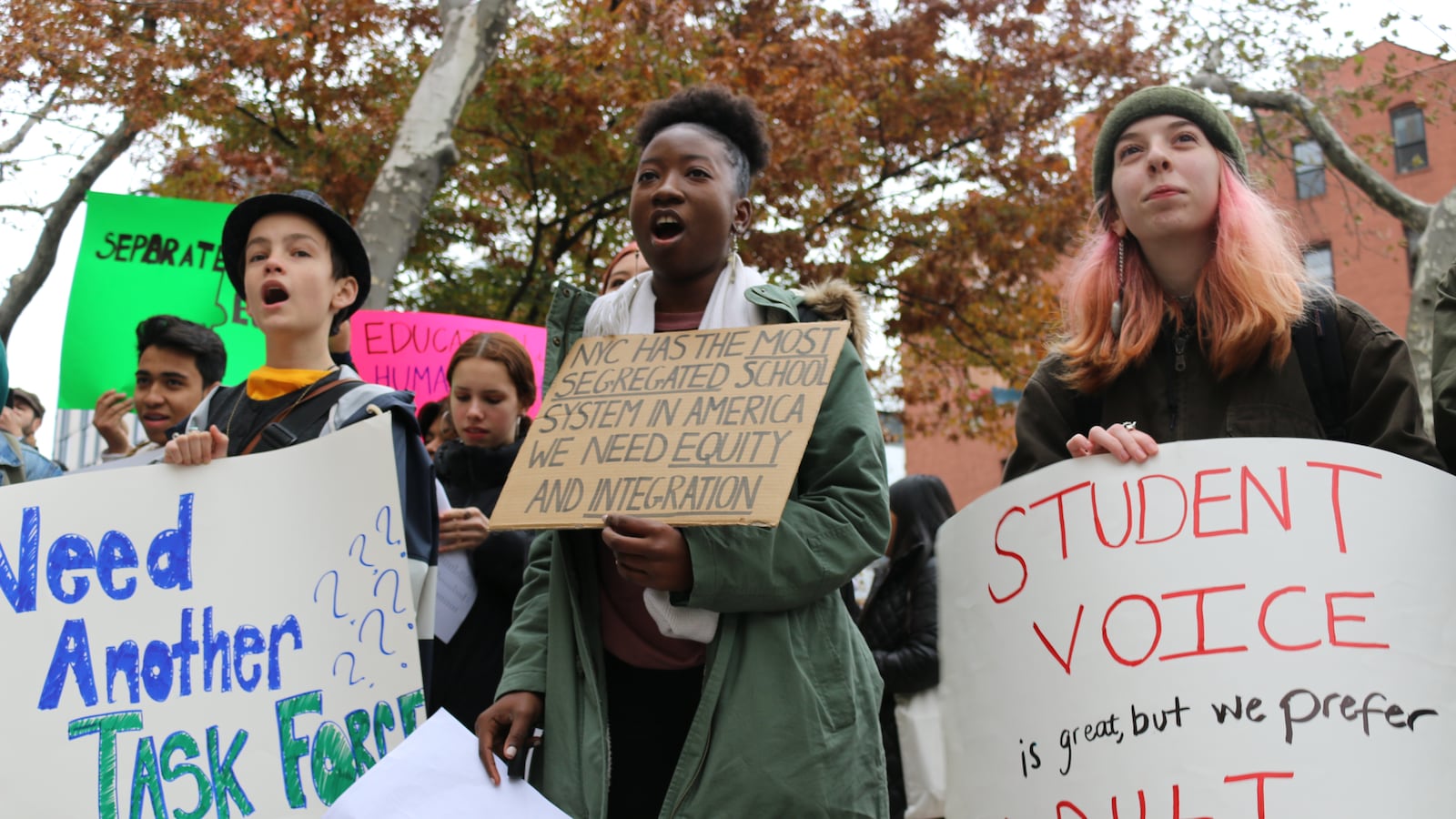Every morning, students from two different schools stream into a shared building in Hudson Square, offering a stark example of segregation in the country’s largest school system.
Through one door, students head to NYC iSchool, a selective school where 46% of enrollment is white — in a school system where more than two-thirds of students are black or Hispanic. A separate entrance leads to Chelsea Career and Technical Education High School, where only 4% of students are white. Separated by a flight of stairs, there is little opportunity for them to meet.
But on Monday morning, students from both schools came together to push for bold action to integrate New York City high schools — including their own. It was the first in a wave of strikes that student activists with Teens Take Charge pledge will continue every Monday. With these protests, they are borrowing a page from the playbook of 16-year-old climate activist Greta Thunberg, who last year began protesting weekly in her native Sweden and went on to inspire a worldwide movement.
The New York City teens said they will keep it up, with the hopes of building a citywide movement, until Mayor Bill de Blasio and schools Chancellor Richard Carranza meet their demands.
“This is a systematic issue that needs a citywide solution,” Carla Gaveglia, a senior at the iSchool who helped organize the protest, told a cheering crowd. “De Blasio and Carranza need to do better. They must do better. And they must know that our voices matter.”
Officials at City Hall and the education department pointed to recent integration efforts put forward by the de Blasio administration. They cited $2 million in grants to school districts working on their own diversity plans — something that all districts will soon have to create, according to a City Council bill passed last week. The mayor is also weighing policy changes recommended by a school diversity task force he appointed.
“Our schools are stronger when they reflect the diversity of our city, and we’re taking a look at our admissions processes,” City Hall spokeswoman Jane Meyer wrote in an email. “We thank Teens Take Charge for raising their voice.”
About 150 students filled a small park that fronts their school building beginning at 8:45 a.m. They held signs with messages such as, “We need equity,” and chanted in unison “Educate, don’t segregate!” At one point they linked arms before streaming into their separate entrances for class. The rally lasted for 30 minutes, or 1,800 seconds — roughly one second for each public school in New York City, which is home to one of the country’s most segregated school systems.
Alexander Ruiz, a senior at Chelsea CTE, helped organize the walkout. With his high school graduation on the horizon, he sees that students at the iSchool heading to more selective universities than his own classmates.
“It’s not because they’re smarter than me. It’s just that they’ve been given the supplemental tools, while I haven’t,” he said, noting that he wishes he had more access to college counselors who could have helped him reached higher. “It’s not the same playing field. It’s not fair at all.”
In New York City, students must apply to high schools, and the schools are allowed to set their own competitive admissions criteria. At iSchool, for example, students have to type up short answers to a series of questions. (The school also recently tweaked its admissions to give certain students priority, in the hopes of spurring more integration.) Teens Take Charge wants the city to abolish high school screens, such as test scores or attendance records, which integration advocates blame for deepening segregation.
“In this building, we see the achievement gap, wealth gap, and opportunity gap. This is what the system has put in place,” said Chris Gonzalez, a senior at Chelsea CTE who spoke at the rally.
Instead, the group is calling for all schools to admit students with a range of academic abilities, breaking up concentrations of students who struggle — which can overwhelm schools trying to help them catch up. Also among the demands: more guidance counselors and college counselors in schools where most students have fallen behind grade level, as well as paid internships, and opportunities to share resources such as advanced courses and sports teams at nearby campuses.
Correction: An earlier version of this story misidentified the neighborhood where NYC iSchool and Chelsea Career and Technical Education High School are located.

